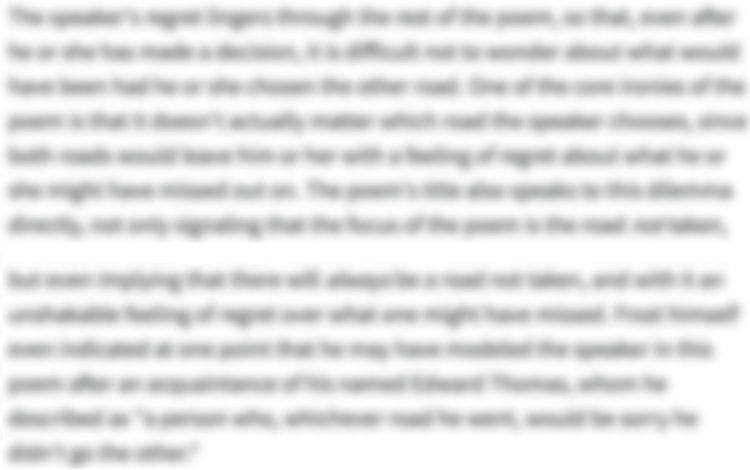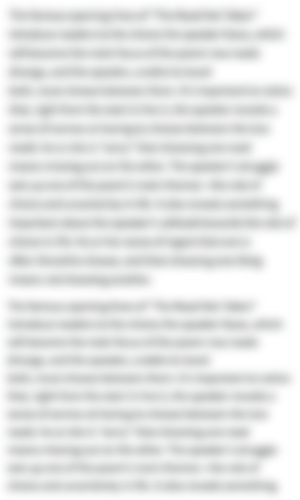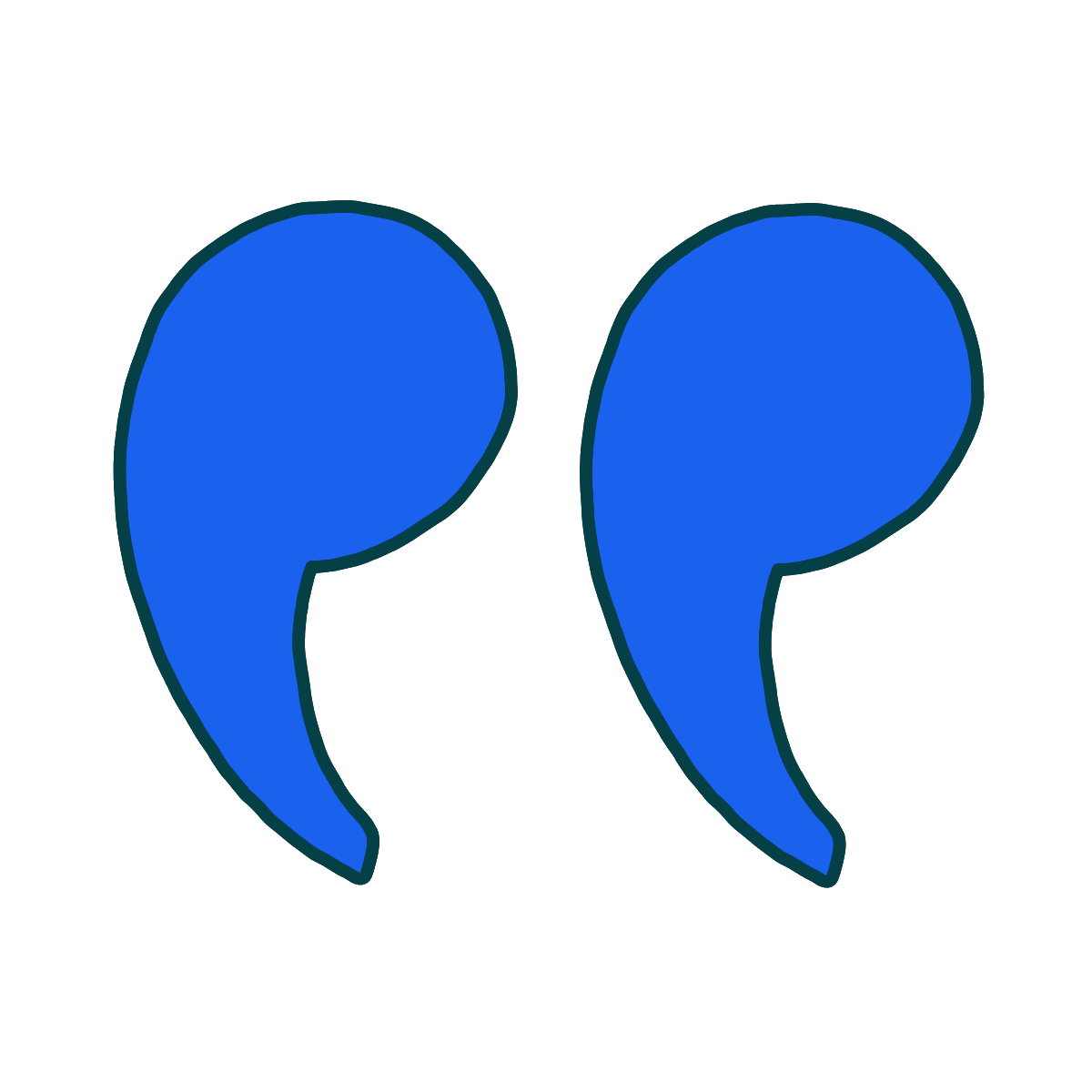The Full Text of “Old Man”
1At six years old I had before mine eyes
2A picture painted, like the rainbow, bright,
3But far, far off in th' unapproachable distance.
4With all my childish heart I longed to reach it,
5And strove and strove the livelong day in vain,
6Advancing with slow step some few short yards
7But not perceptibly the distance lessening.
8At threescore years old, when almost within
9Grasp of my outstretched arms the selfsame picture
10With all its beauteous colors painted bright,
11I'm backward from it further borne each day
12By an invisible, compulsive force,
13Gradual but yet so steady, sure, and rapid,
14That at threescore and ten I'll from the picture
15Be even more distant than I was at six.
-
“Old Man” Introduction
-
"Old Man" is an 1854 poem by Irish scholar and poet James Henry. The poem's speaker (the "Old Man" of the title) compares life at age sixty to life at age six. He draws a surprising parallel between these two times in his life: during both, he yearned for some beautiful "picture" or ideal vision, but could never reach it, despite his best efforts. He no longer believes it's attainable, either; he observes that an "invisible, compulsive force" seems to pull him back farther from it each day. The poem never specifies what this rainbow-like picture represents, but it might refer to happiness, meaning, and/or a general sense of fulfillment.
-
-
“Old Man” Summary
-
When I was six, I saw a painted image ahead of me. It resembled a dazzling rainbow, but it looked unreachably distant. My whole younger self yearned to get to this image, and I tried over and over all day, but with no luck. I'd move toward it, slowly, a handful of feet at a time, but I never seemed to close the gap by much.
Now that I'm sixty, I'm practically close enough to touch that same image, with its glorious range of vibrant, painted colors. And yet: every day I'm pulled farther away from the image by some unseen, irresistible force, which works on me bit by bit—continually, firmly, and swiftly. Because of this force, I'll be even farther away from the image by the time I'm seventy than I was when I was six.
-
-
“Old Man” Themes
-

Hope, Disappointment, and Aging
In "Old Man," a sixty-year-old speaker compares his current life with his life at age six, finding some surprising common ground between the two. At both ages, the speaker felt/feels an almost inexpressible longing for something "far off," described as a "bright," rainbow-like "picture." This might be a vision of how life should be, or the belief that life will all make sense one day; whatever it is, the speaker hoped for it then and hopes for it still. With the benefit of experience, however, the aging speaker knows that his ideal vision isn't getting any closer. In fact, it seems even farther away than it was when he was six. Broadly, then, the poem depicts life as the constant pursuit of an impossible dream.
The speaker recalls a "picture" he strained to "reach" as a child: the dream of an ideal life. The poem describes this picture as "painted, like the rainbow, bright, / But far, far off in th'unapproachable distance." It's a glimpse of a more beautiful world; perhaps it's what the child-speaker felt awaited him as an adult. Life sets up expectations, hopes, and dreams, which together form a kind of fantasy land: a place just over the horizon where everything will be bright, beautiful, and joyful. The speaker "strove the livelong day" (worked constantly) to reach his ideal. His hopeful desire filled his "childish heart" and defined his youth.
Now sixty, the speaker feels a little closer to this "selfsame picture," yet it still seems beyond his "grasp." Decades of accumulated experience and wisdom haven't been enough to make his dream a reality. That dream, "With all its beauteous colors painted bright," still holds the same magical allure it once did. His "outstretched arms" try and fail to hold it. But for all his best efforts, the speaker feels "an invisible, compulsive force" pulling him away from his dream "each day." Pretty soon, the speaker thinks, the dream will be even farther away than it was when he was six. The invisible "force" might be the aging process itself, which robs the speaker of time, energy, willpower, etc. Or he might feel that the more he sees of the real world, the less credible his dream becomes.
Regardless, his ideal remains as unattainable as ever—it never was within reach. By extension, life never lives up to our most cherished dreams. The speaker's life has entered its later stages, and he no longer expects to attain his ideal "picture." Again, he never clearly defines this "picture," but that's part of why the poem packs a punch. Everyone can relate to the hope that some "bright[er]," better life is on the horizon, even if different people define this life differently. The generic nature of the speaker's ideal turns the poem into a broader statement on the human condition. People want to feel purpose and meaning; they nurture dreams and long to understand what life is all about. But the poem suggests that, even if we spend all our years striving for such fulfillment, it will ultimately elude us.
- See where this theme is active in the poem.
-
-
Line-by-Line Explanation & Analysis of “Old Man”
-
Lines 1-3
At six years old I had before mine eyes
A picture painted, like the rainbow, bright,
But far, far off in th' unapproachable distance.The speaker is the "Old Man" of the title, and he's in a reflective mood. He begins by describing a picture he used to see "before [his] eyes," though the rest of the poem makes clear that this image is really in his mind (he's not talking about a physical painting).
Line 1 uses enjambment to create a brief moment of tension, which leaves the reader to guess what's coming next. Line 2 reveals that the speaker used to see "A picture painted, like the rainbow, bright." Decorative alliteration helps evoke the beauty of the picture; those, punchy plosive /p/s also hint at the picture's powerful impact on the speaker's life.
The speaker compares this picture—which he never describes in detail—to "the rainbow, bright." His simile suggests that the picture was beautiful and awe-inspiring, but also a kind of illusion. Rainbows exist only as a trick of the light; they might look solid, but one can never get close to them and touch them. Already, then, the poem hints that this isn't a real picture but a symbolic vision, reflecting some fundamental promise and/or disappointment related to life itself.
Indeed, this picture only ever appeared "far, far off in th'unapproachable distance." The emphatic epizeuxis of "far, far" makes this distance seem all the more "unapproachable." If the reader is wondering, by now, what the picture means—well, that's kind of the point. As a child, the speaker felt a deep-rooted longing for something, but he didn't know then (and doesn't know now) precisely what it was. The juxtaposition established by the title is important here: this is an "Old Man" reflecting on his time as a kid, when the world seemed new and beautiful. Perhaps, back then, he felt instinctively optimistic that his future life would turn out as he hoped. Or maybe this far-off "picture" held out the promise that the confusion of childhood would someday resolve into certainty. In any case, he yearned for something that wasn't yet his.
These opening lines also establish the poem's form. "Old Man" is written in iambic pentameter, meaning that most of its lines contain five metrical feet following an unstressed-STRESSED pattern (da-DUM). Listen to lines 1-2, for example:
At six | years old | I had | before | mine eyes
A pic-| ture paint-| ed, like | the rain-| bow, bright,This steady, measured rhythm seems appropriate for someone speaking from long experience, reflecting soberly on the idealism of his younger days.
-
Lines 4-7
With all my childish heart I longed to reach it,
And strove and strove the livelong day in vain,
Advancing with slow step some few short yards
But not perceptibly the distance lessening.

Unlock all 385 words of this analysis of Lines 4-7 of “Old Man,” and get the Line-by-Line Analysis for every poem we cover.
Plus so much more...
Get LitCharts A+ -
Lines 8-11
At threescore years old, when almost within
Grasp of my outstretched arms the selfsame picture
With all its beauteous colors painted bright,
I'm backward from it further borne each day -
Lines 12-15
By an invisible, compulsive force,
Gradual but yet so steady, sure, and rapid,
That at threescore and ten I'll from the picture
Be even more distant than I was at six.
-
-
“Old Man” Symbols
-

Rainbow
The speaker compares his "picture" of an ideal life to "the rainbow." Rainbows are traditional symbols of unattainable beauty, since they're vibrant, mirage-like, and untouchable (basically a trick of the light).
They also appear in many myths and fairy tales, where they're often associated with fantasy lands. In Irish folklore, for instance, leprechauns stash their gold at the end of the rainbow. (There's also the famous land beyond the rainbow in The Wizard of Oz, though that book was written decades after "Old Man.") Rainbows can carry religious symbolism, too; in the Bible, a rainbow appears as a blessing after the Great Flood and represents God's promise never to destroy the earth again.
Thus, the rainbow in the poem might represent beauty, happiness, good fortune, or a blessed state. Whatever it represents, it's unattainable!
- See where this symbol appears in the poem.
-
-
“Old Man” Poetic Devices & Figurative Language
-
Alliteration
"Old Man" uses alliteration for both musical and dramatic effect.
Since he was six, the speaker has seen a "picture painted" (line 2) before his eyes (though really it's in his mind). It's an inviting, rainbow-like vision, though it remains always out of reach—even now, when he's sixty. That /p/ alliteration has a decorative effect, perhaps suggesting the beauty of this strange yet alluring image. This /p/ is also a punchy, plosive sound, hinting at the picture's impact on the speaker's entire life.
The speaker then describes how, as a kid, he "strove" to "reach" that picture. He advanced towards it with "slow step some few short yards" (line 6). These sibilant /s/ sounds "slow" the poem's pace, mirroring the speaker's movement as the picture remains tantalizingly out of reach. As the following line dials up the sibilance ("perceptibly the distance lessening"), the hushed, whispery tones create an atmosphere of mystery and uncertainty—as if the picture is a kind of ghost that haunts the speaker. This sibilant sound returns in line 13 as well ("so steady").
In lines 10 and 11, the poem deploys more plosive sounds:
With all its beauteous colors painted bright,
I'm backward from it further borne each day [...]As with "picture painted" in line 2, these are bold, compelling sounds that capture the magnetic pull of that far-off picture. But line 11 modifies this effect by using the same sound to describe how the picture remains forever out of reach. The speaker feels he is "backward [...] borne," receding further away from what he yearns for. Here, the plosives convey the strength of the "compulsive force" that imposes itself on the speaker's life—whether at age six or sixty!
- See where this poetic device appears in the poem.
-
Enjambment


Unlock all 267 words of this analysis of Enjambment in “Old Man,” and get the poetic device analyses for every poem we cover.
Plus so much more...
Get LitCharts A+ -
Juxtaposition
-
Repetition
-
Simile
-
-
“Old Man” Vocabulary
Select any word below to get its definition in the context of the poem. The words are listed in the order in which they appear in the poem.
- Mine
- Th'unapproachable
- Strove
- The livelong day
- In vain
- Perceptibly
- Threescore
- Selfsame
- Beauteous
- Borne
- Compulsive
- Threescore and ten
Mine-
Archaic form of "my."
- See where this vocabulary word appears in the poem.
-
Form, Meter, & Rhyme Scheme of “Old Man”
-
Form
"Old Man" consists of one 15-line stanza, in which the speaker compares his feelings as a kid to his feelings as an old man. The fact that he traces this comparison in a single, uninterrupted block of text might reflect the way not much has changed for him. He yearns for something unattainable now, just as he always has. The yearning has been a constant in his life, and the lack of a stanza break reflects this continuity.
It's also worth noting that, at fifteen lines, the poem is only one line longer than a traditional sonnet. Sonnets often feature longing as their subject, and they typically share this poem's meter (iambic pentameter) as well. "Old Man" could be read as a kind of warped, unrhymed sonnet, in which the speaker's longing is doomed to remain frustrated.
-
Meter
"Old Man" uses iambic pentameter: lines with five metrical feet, each of which has an unstressed-stressed pattern of syllables (da-DUM). Here's line 1 as an example of the meter at work:
At six | years old | I had | before | mine eyes
The meter gives the poem a steady, regular motion, like the speaker's "slow[ly]" advancing "step[s]" in line 6. It might also evoke the "steady" and "compulsive force" that pulls the speaker away from his longed-for vision. The meter works in the poem's background much as that force does in the speaker's life.
Like most metrical poems, "Old Man" contains a few variations in rhythm. One example is the trochee (DUM-da) at the start of line 9, which helps capture the speaker's strained, frustrated tone by emphasizing the first word: "Grasp of."
-
Rhyme Scheme
"Old Man" has no rhyme scheme, or any rhyme at all. As a result, it has a straightforward, unfiltered quality, as if rhyme would be too neat and contrived a formal choice. Rhymes often suggest resolution, pairing up with a satisfying click. The speaker's point here is that life never really resolves into that bright, hoped-for picture.
-
-
“Old Man” Speaker
-
The poem's speaker is the "Old Man" of the title. Now that he's sixty, he's in a reflective mood—but he doesn't offer the pearls of wisdom the reader might expect. Instead, he observes that being sixty isn't so different from being six, because for him, both ages are defined by an insatiable yearning. Since early childhood, he's pursued "a picture painted" before his mind's eye: a bright, idealized vision. He still yearns for it now, except that he's not naive enough to think he can actually reach it. Some "invisible, compulsive force" (perhaps aging itself, perhaps life's inherent limitations and disappointments) continually prevents him from achieving his goal. He's looking ahead to his death, which he views as an end but not a resolution to his questions about life.
It's worth noting that "Old Man" has a companion poem, "Very Old Man," written from the same perspective ten years later ("at threescore and ten").
-
-
“Old Man” Setting
-
"Old Man" contrasts two moments in time, but doesn't describe a physical or geographical setting. The poem juxtaposes the speaker at age six (the past) and age sixty (the poem's present). It also looks ahead ten years to when the speaker will be seventy (check out the companion poem, Henry's "Very Old Man," for more). Broadly, this old man still yearns for the same unattainable thing as he did when he was a kid. He calls this unattainable ideal "a picture painted"—a bright, rainbow-like vision of some other place, time, experience, or way of life. The vagueness of his vision is part of its power, and he depicts his frustrated longing as an attempt to traverse an impossible distance—as though he's been trying to reach some destination that doesn't really exist.
-
-
Literary and Historical Context of “Old Man”
Literary Context
James Henry (1798-1876) was an Irish poet, physician, and classical scholar. He was educated at Trinity College, Dublin, and worked in medicine until 1845. His literary work was largely neglected during his life and isn't very widely read in the present day, either. He self-published five collections of his own work, and it wasn't until his inclusion in the New Oxford Book of Victorian Verse in 1987 that his poetry began to receive some attention. Henry was heavily influenced by classical literature and spent much of his life researching and writing about the ancient Roman poet Virgil.
Though Henry was—and remains—an obscure figure, the 19th century was full of some of poetry's biggest names. "Old Man" was written and published in 1854, during a period defined by the work of poets like Elizabeth Barrett Browning, Robert Browning, Christina Rossetti, and Alfred, Lord Tennyson.
"Old Man" has a companion or sequel poem called, appropriately, "Very Old Man." In this poem, the speaker is "threescore and ten" (seventy) as anticipated in line 14. During the intervening decade, the speaker's prediction has come true: life seems more mysterious, fleeting, and frustrating than ever.
Historical Context
James Henry wrote during the reign of Queen Victoria (who ruled England from 1831 to 1901), a time of massive scientific, societal, and religious upheavals. Considered a literary golden age, the Victorian era saw writers grappling with vast shifts in the religious, moral, and class structures of their world. New ideas such as Darwin's theory of evolution challenged people's conception of their place in society, while the rise of dangerous factory work and economic disparity prompted social reformers to focus increasingly on poverty, child labor, and the mistreatment of women.
Henry worked for many years as a physician and wrote a number of provocative pamphlets about various aspects of the medical profession. He eventually made enough money to abandon medicine and devote himself to his true passion: Virgil. From 1848 on, Henry traveled around Europe with his wife and daughter, examining every Virgil manuscript he could find. He chronicled some of these travels in verse before returning to Ireland to live out his later years. "Old Man" was written when he was in his late fifties, so not far off the speaker's sixty years of age.
-
More “Old Man” Resources
-
External Resources
-
Henry's Poetry and Philosophy — Poet David Wheatley discusses Henry's neglected poetry and his views on religion.
-
The New Oxford Book of Victorian Verse — Check out the seminal 1987 anthology in which a handful of Henry's poems were published.
-
James Henry Biography — Learn more about the poet's life over at the Dictionary of Irish Biography.
-
Christopher Ricks on Henry — Literary critic Christopher Ricks talks about discovering Henry's work while compiling an anthology of Victorian poetry.
-
-
LitCharts on Other Poems by James Henry
-








